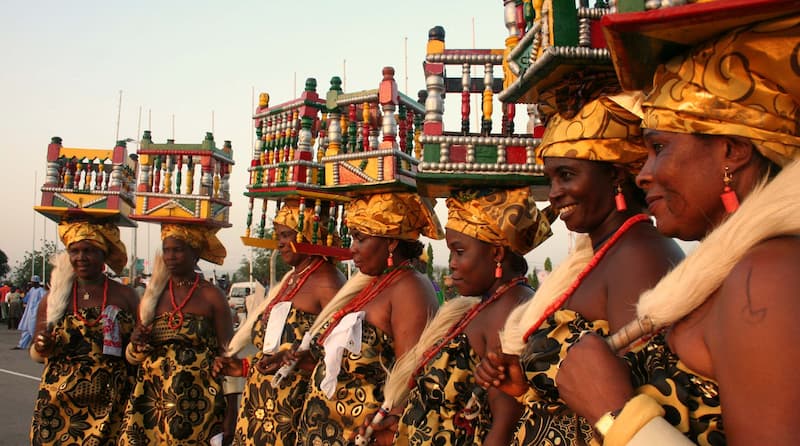The Ashanti tribe, which is located in central Ghana, is the largest tribe in the region and has a population of over 5,000,000 people. They dwell in the West African Rainforest, which is approximately 150 miles distant from the West Coast.
The Ashanti tribe is the largest indigenous tribe among the Akan tribes (Ashanti, Bono, Akyim, and Fanti) in Ghana and is also known as the Asante. Ghana is a relatively young country with a history of only roughly 60 years, and it was previously known as the Gold Coast. From 1670 to 1902, the Ashanti tribe ruled over the majority of what is now the Republic of Ghana.
At the time, Ashanti was the most powerful and largest of the states founded by the ‘Akans’ in the forest area of southern Ghana. Gold was abundant among the Akans, and it was this wealth that enabled them to establish a state. Even now, the Ashanti are Ghana’s largest tribe, divided into four governmental regions. The tribe, which occupies 9400 square miles of territory and has a population of over five million people, is located in the heart of Ghana, with Kumasi as its capital.
History of Ashanti
In 1670, the Ashanti became the dominant power. It subjugated the tribes to the left, right, and center, establishing a monopoly on the sea routes. Kumasi, the capital, developed into a functional urban center with services and facilities comparable to those found in Europe at the time.
As a result, it became one of Europe’s most important trading centers. Beginning with the Portuguese, the British, French, Dutch, and other Europeans gradually erected forts along the coasts, sharing trades like as gold, raw resources, and slaves.
The Ashanti Kingdom fell after the slave trade was prohibited in the 19th century. The Gold Coast was occupied by the British at the time. As a result, the two countries fought multiple conflicts, culminating in the British taking control of Kumasi, the capital in 1874. They gradually took control of the main gold coasts and the Ashanti. The British colonization of the Gold Coast was established after conquering the Ashantes.
The People of Ghana
The Ashanti people had a reputation for being ruthless warriors. “If I walk on, I will die,” they said over and over. I’m going to die if I take one more step backward. It is preferable to advance and die.” They used to signal war with drum strokes so loud that the sound could be heard for kilometers across the impenetrable woodlands.
People shake hands in a traditional manner, holding out their left hand. The left hand is used to handle shields, while the right hand is used for swords and spears, according to this traditional practice. As a result, keeping the shield aside frees up the left hand to exhibit trust in someone. They continue to shake hands in the same manner.
The Ashanti believe that their soul is their father’s spirit and that their blood and flesh are from their mother. As a result, they are thought to be more maternal. The Ashantis live in a joint family with the eldest brother as the family’s head, who is chosen by the family’s elders. Everyone follows him and obeys him, and he becomes the family’s or house’s leader. The family is housed in huts that are enclosed by a courtyard fence
Religion & Culture
Ashanti religion is a blend of spiritual and supernatural beliefs. Plants, trees, and animals are believed to have souls, according to them. Forest monsters, witches, and fairies are also a part of their mythology.
They have a wide range of religious beliefs, which are based on ancestors, abosom or higher gods, and ‘Nyame,’ Ashanti’s primary Supreme Being. Different rites of passage for birth, death, marriage, and puberty are also performed on individuals. The Ashanti have a tradition of holding various rituals to commemorate important events in their lives. Their funerals are held in front of the entire village and last for several days. The presence of every villager is critical during the ceremonies.
The Ashanti Golden Stool
According to the Ashanti, the golden stool is a holy object they value and cherish at the expense of their lives. In the 21st century, the Ashanti tribe continues to live according to the Golden Stool’s traditions. They protect the Golden Stool very carefully. Since its arrival, it has never touched the ground and no one has ever sat on it. It is kept in a very tight security as it has always been considered sacred. Because it has traditionally been regarded sacred, it is guarded with extreme care.
The Ashantis are regarded as experts in a wide variety of specialized crafts. Wood carving, weaving, the world-famous kente textiles, metallurgy, and ceramics are some of the crafts practiced in the region. All save pottery-making is intended for male specialists, and only pottery-making is designed to be done by a female craftsperson. Even in the manufacture of pottery, only male specialists are allowed to design the pottery and pipes.
